Molecule Information
General Information of the Molecule (ID: Mol00092)
| Name |
Isocitrate dehydrogenase NADP 2 (IDH2)
,Homo sapiens
|
||||
|---|---|---|---|---|---|
| Synonyms |
IDH; ICD-M; IDP; NADP(+)-specific ICDH; Oxalosuccinate decarboxylase
Click to Show/Hide
|
||||
| Molecule Type |
Protein
|
||||
| Gene Name |
IDH2
|
||||
| Gene ID | |||||
| Location |
chr15:90083045-90102477[-]
|
||||
| Sequence |
MAGYLRVVRSLCRASGSRPAWAPAALTAPTSQEQPRRHYADKRIKVAKPVVEMDGDEMTR
IIWQFIKEKLILPHVDIQLKYFDLGLPNRDQTDDQVTIDSALATQKYSVAVKCATITPDE ARVEEFKLKKMWKSPNGTIRNILGGTVFREPIICKNIPRLVPGWTKPITIGRHAHGDQYK ATDFVADRAGTFKMVFTPKDGSGVKEWEVYNFPAGGVGMGMYNTDESISGFAHSCFQYAI QKKWPLYMSTKNTILKAYDGRFKDIFQEIFDKHYKTDFDKNKIWYEHRLIDDMVAQVLKS SGGFVWACKNYDGDVQSDILAQGFGSLGLMTSVLVCPDGKTIEAEAAHGTVTRHYREHQK GRPTSTNPIASIFAWTRGLEHRGKLDGNQDLIRFAQMLEKVCVETVESGAMTKDLAGCIH GLSNVKLNEHFLNTTDFLDTIKSNLDRALGRQ Click to Show/Hide
|
||||
| Function |
Plays a role in intermediary metabolism and energy production. It may tightly associate or interact with the pyruvate dehydrogenase complex.
Click to Show/Hide
|
||||
| Uniprot ID | |||||
| Ensembl ID | |||||
| HGNC ID | |||||
| Click to Show/Hide the Complete Species Lineage | |||||
Type(s) of Resistant Mechanism of This Molecule
Drug Resistance Data Categorized by Drug
Approved Drug(s)
1 drug(s) in total
| Drug Resistance Data Categorized by Their Corresponding Mechanisms | ||||
|
|
||||
| Disease Class: Glioblastoma | [1] | |||
| Resistant Disease | Glioblastoma [ICD-11: 2A00.02] | |||
| Resistant Drug | Dichloroacetate | |||
| Molecule Alteration | Expression | Up-regulation |
||
| Experimental Note | Identified from the Human Clinical Data | |||
| Cell Pathway Regulation | Cell migration | Activation | hsa04670 | |
| Cell proliferation | Activation | hsa05200 | ||
| In Vitro Model | DBTRG cells | Brain | Homo sapiens (Human) | CVCL_1169 |
| Experiment for Molecule Alteration |
Western blot analysis; RT-qPCR | |||
| Experiment for Drug Resistance |
Colorimetric SRB assay | |||
| Mechanism Description | The potential of miR-144 overexpression to reduce GB cell malignancy, both by decreasing Cell migration and invasion abilities and by sensitizing resistant tumor cells to chemotherapy, paving the way to a novel and more effective GB therapy. | |||
Clinical Trial Drug(s)
1 drug(s) in total
| Drug Sensitivity Data Categorized by Their Corresponding Mechanisms | ||||
|
|
||||
| Disease Class: Acute myeloid leukemia | [2] | |||
| Sensitive Disease | Acute myeloid leukemia [ICD-11: 2A60.0] | |||
| Sensitive Drug | Enasidenib | |||
| Molecule Alteration | Missense mutation | p.R140G (c.418C>G) |
||
| Experimental Note | Identified from the Human Clinical Data | |||
| Mechanism Description | Continuous daily enasidenib treatment was generally well tolerated and induced hematologic responses in patients for whom prior AML therapy had failed. Inducing differentiation of myeloblasts, not cytotoxicity, seems to drive the clinical efficacy of enasidenib. | |||
| Disease Class: Acute myeloid leukemia | [2] | |||
| Sensitive Disease | Acute myeloid leukemia [ICD-11: 2A60.0] | |||
| Sensitive Drug | Enasidenib | |||
| Molecule Alteration | Missense mutation | p.R140W (c.418C>T) |
||
| Experimental Note | Identified from the Human Clinical Data | |||
| Mechanism Description | Continuous daily enasidenib treatment was generally well tolerated and induced hematologic responses in patients for whom prior AML therapy had failed. Inducing differentiation of myeloblasts, not cytotoxicity, seems to drive the clinical efficacy of enasidenib. | |||
| Disease Class: Acute myeloid leukemia | [2] | |||
| Sensitive Disease | Acute myeloid leukemia [ICD-11: 2A60.0] | |||
| Sensitive Drug | Enasidenib | |||
| Molecule Alteration | Missense mutation | p.R140L (c.419G>T) |
||
| Experimental Note | Identified from the Human Clinical Data | |||
| Mechanism Description | Continuous daily enasidenib treatment was generally well tolerated and induced hematologic responses in patients for whom prior AML therapy had failed. Inducing differentiation of myeloblasts, not cytotoxicity, seems to drive the clinical efficacy of enasidenib. | |||
| Disease Class: Acute myeloid leukemia | [2] | |||
| Sensitive Disease | Acute myeloid leukemia [ICD-11: 2A60.0] | |||
| Sensitive Drug | Enasidenib | |||
| Molecule Alteration | Missense mutation | p.R172G (c.514A>G) |
||
| Experimental Note | Identified from the Human Clinical Data | |||
| Mechanism Description | Continuous daily enasidenib treatment was generally well tolerated and induced hematologic responses in patients for whom prior AML therapy had failed. Inducing differentiation of myeloblasts, not cytotoxicity, seems to drive the clinical efficacy of enasidenib. | |||
| Disease Class: Acute myeloid leukemia | [2] | |||
| Sensitive Disease | Acute myeloid leukemia [ICD-11: 2A60.0] | |||
| Sensitive Drug | Enasidenib | |||
| Molecule Alteration | Missense mutation | p.R172W (c.514A>T) |
||
| Experimental Note | Identified from the Human Clinical Data | |||
| Mechanism Description | Continuous daily enasidenib treatment was generally well tolerated and induced hematologic responses in patients for whom prior AML therapy had failed. Inducing differentiation of myeloblasts, not cytotoxicity, seems to drive the clinical efficacy of enasidenib. | |||
| Disease Class: Acute myeloid leukemia | [2] | |||
| Sensitive Disease | Acute myeloid leukemia [ICD-11: 2A60.0] | |||
| Sensitive Drug | Enasidenib | |||
| Molecule Alteration | Missense mutation | p.R172M (c.515G>T) |
||
| Experimental Note | Identified from the Human Clinical Data | |||
| Mechanism Description | Continuous daily enasidenib treatment was generally well tolerated and induced hematologic responses in patients for whom prior AML therapy had failed. Inducing differentiation of myeloblasts, not cytotoxicity, seems to drive the clinical efficacy of enasidenib. | |||
| Disease Class: Acute myeloid leukemia | [2] | |||
| Sensitive Disease | Acute myeloid leukemia [ICD-11: 2A60.0] | |||
| Sensitive Drug | Enasidenib | |||
| Molecule Alteration | Missense mutation | p.R172S (c.516G>C) |
||
| Experimental Note | Identified from the Human Clinical Data | |||
| Mechanism Description | Continuous daily enasidenib treatment was generally well tolerated and induced hematologic responses in patients for whom prior AML therapy had failed. Inducing differentiation of myeloblasts, not cytotoxicity, seems to drive the clinical efficacy of enasidenib. | |||
| Disease Class: Hematologic Cancer | [3] | |||
| Sensitive Disease | Hematologic Cancer [ICD-11: MG24.Y] | |||
| Sensitive Drug | Enasidenib | |||
| Molecule Alteration | Missense mutation | p.R140K (c.418_419delCGinsAA) |
||
| Experimental Note | Identified from the Human Clinical Data | |||
| Disease Class: Hematologic Cancer | [3] | |||
| Sensitive Disease | Hematologic Cancer [ICD-11: MG24.Y] | |||
| Sensitive Drug | Enasidenib | |||
| Molecule Alteration | Missense mutation | p.R172K (c.515G>A) |
||
| Experimental Note | Identified from the Human Clinical Data | |||
| Disease Class: Acute myeloid leukemia | [2] | |||
| Sensitive Disease | Acute myeloid leukemia [ICD-11: 2A60.0] | |||
| Sensitive Drug | Enasidenib | |||
| Molecule Alteration | Missense mutation | p.R140Q (c.419G>A) |
||
| Experimental Note | Identified from the Human Clinical Data | |||
| In Vitro Model | U87MG cells | Brain | Homo sapiens (Human) | CVCL_GP63 |
| TF-1 cells | Bone marrow | Homo sapiens (Human) | CVCL_0559 | |
| In Vivo Model | Acute myeloid leukemia xenograft mouse model | Mus musculus | ||
| Experiment for Drug Resistance |
IC50 assay | |||
| Disease Class: Acute myeloid leukemia | [2] | |||
| Sensitive Disease | Acute myeloid leukemia [ICD-11: 2A60.0] | |||
| Sensitive Drug | Enasidenib | |||
| Molecule Alteration | Missense mutation | p.R172K (c.515G>A) |
||
| Experimental Note | Identified from the Human Clinical Data | |||
| In Vitro Model | U87MG cells | Brain | Homo sapiens (Human) | CVCL_GP63 |
| TF-1 cells | Bone marrow | Homo sapiens (Human) | CVCL_0559 | |
| In Vivo Model | Acute myeloid leukemia xenograft mouse model | Mus musculus | ||
| Experiment for Drug Resistance |
IC50 assay | |||
|
|
||||
| Disease Class: FGFR-tacc positive glioblastoma | [4] | |||
| Sensitive Disease | FGFR-tacc positive glioblastoma [ICD-11: 2A00.01] | |||
| Sensitive Drug | Enasidenib | |||
| Molecule Alteration | Missense mutation | p.R172K (c.515G>A) |
||
| Experimental Note | Identified from the Human Clinical Data | |||
| In Vitro Model | U87MG cells | Brain | Homo sapiens (Human) | CVCL_GP63 |
| TF-1 cells | Bone marrow | Homo sapiens (Human) | CVCL_0559 | |
| TF-1a cells | Bone marrow | Homo sapiens (Human) | CVCL_3608 | |
| IDH2 cells | N.A. | Homo sapiens (Human) | N.A. | |
| In Vivo Model | NSG mouse PDX model | Mus musculus | ||
| Mechanism Description | Somatic gain-of-function mutations in isocitrate dehydrogenases (IDH) 1 and 2 are found in multiple hematologic and solid tumors, leading to accumulation of the oncometabolite (R)-2-hydroxyglutarate (2HG). 2HG competitively inhibits alpha-ketoglutarate-dependent dioxygenases, including histone demethylases and methylcytosine dioxygenases of the TET family, causing epigenetic dysregulation and a block in cellular differentiation. | |||
| Disease Class: Colorectal cancer | [4] | |||
| Sensitive Disease | Colorectal cancer [ICD-11: 2B91.1] | |||
| Sensitive Drug | Enasidenib | |||
| Molecule Alteration | Missense mutation | p.R172K (c.515G>A) |
||
| Experimental Note | Identified from the Human Clinical Data | |||
| In Vitro Model | U87MG cells | Brain | Homo sapiens (Human) | CVCL_GP63 |
| TF-1 cells | Bone marrow | Homo sapiens (Human) | CVCL_0559 | |
| TF-1a cells | Bone marrow | Homo sapiens (Human) | CVCL_3608 | |
| IDH2 cells | N.A. | Homo sapiens (Human) | N.A. | |
| In Vivo Model | NSG mouse PDX model | Mus musculus | ||
| Mechanism Description | Somatic gain-of-function mutations in isocitrate dehydrogenases (IDH) 1 and 2 are found in multiple hematologic and solid tumors, leading to accumulation of the oncometabolite (R)-2-hydroxyglutarate (2HG). 2HG competitively inhibits alpha-ketoglutarate-dependent dioxygenases, including histone demethylases and methylcytosine dioxygenases of the TET family, causing epigenetic dysregulation and a block in cellular differentiation. | |||
| Disease Class: FGFR-tacc positive glioblastoma | [4] | |||
| Sensitive Disease | FGFR-tacc positive glioblastoma [ICD-11: 2A00.01] | |||
| Sensitive Drug | Enasidenib | |||
| Molecule Alteration | Missense mutation | p.R140Q (c.419G>A) |
||
| Experimental Note | Identified from the Human Clinical Data | |||
| In Vitro Model | U87MG cells | Brain | Homo sapiens (Human) | CVCL_GP63 |
| TF-1 cells | Bone marrow | Homo sapiens (Human) | CVCL_0559 | |
| TF-1a cells | Bone marrow | Homo sapiens (Human) | CVCL_3608 | |
| IDH2 cells | N.A. | Homo sapiens (Human) | N.A. | |
| In Vivo Model | NSG mouse PDX model | Mus musculus | ||
| Mechanism Description | Somatic gain-of-function mutations in isocitrate dehydrogenases (IDH) 1 and 2 are found in multiple hematologic and solid tumors, leading to accumulation of the oncometabolite (R)-2-hydroxyglutarate (2HG). 2HG competitively inhibits alpha-ketoglutarate-dependent dioxygenases, including histone demethylases and methylcytosine dioxygenases of the TET family, causing epigenetic dysregulation and a block in cellular differentiation. | |||
Preclinical Drug(s)
1 drug(s) in total
| Drug Sensitivity Data Categorized by Their Corresponding Mechanisms | ||||
|
|
||||
| Disease Class: Acute myeloid leukemia | [5] | |||
| Sensitive Disease | Acute myeloid leukemia [ICD-11: 2A60.0] | |||
| Sensitive Drug | AGI-6780 | |||
| Molecule Alteration | Missense mutation | p.R140Q (c.419G>A) |
||
| Experimental Note | Revealed Based on the Cell Line Data | |||
| In Vitro Model | Blood | . | ||
| Mechanism Description | The missense mutation p.R140Q (c.419G>A) in gene IDH2 cause the sensitivity of AGI-6780 by aberration of the drug's therapeutic target | |||
Investigative Drug(s)
1 drug(s) in total
| Drug Sensitivity Data Categorized by Their Corresponding Mechanisms | ||||
|
|
||||
| Disease Class: Acute myeloid leukemia | [3] | |||
| Sensitive Disease | Acute myeloid leukemia [ICD-11: 2A60.0] | |||
| Sensitive Drug | IDH2 inhibitors | |||
| Molecule Alteration | Missense mutation | p.R172K (c.515G>A) |
||
| Experimental Note | Identified from the Human Clinical Data | |||
| Disease Class: Acute myeloid leukemia | [3] | |||
| Sensitive Disease | Acute myeloid leukemia [ICD-11: 2A60.0] | |||
| Sensitive Drug | IDH2 inhibitors | |||
| Molecule Alteration | Missense mutation | p.R140Q (c.419G>A) |
||
| Experimental Note | Identified from the Human Clinical Data | |||
Disease- and Tissue-specific Abundances of This Molecule
ICD Disease Classification 02

| Differential expression of molecule in resistant diseases | ||
| The Studied Tissue | Nervous tissue | |
| The Specified Disease | Brain cancer | |
| The Expression Level of Disease Section Compare with the Healthy Individual Tissue | p-value: 1.21E-01; Fold-change: -6.37E-02; Z-score: -1.02E-01 | |
|
Molecule expression in the diseased tissue of patients
Molecule expression in the normal tissue of healthy individuals
|
||
| Disease-specific Molecule Abundances |
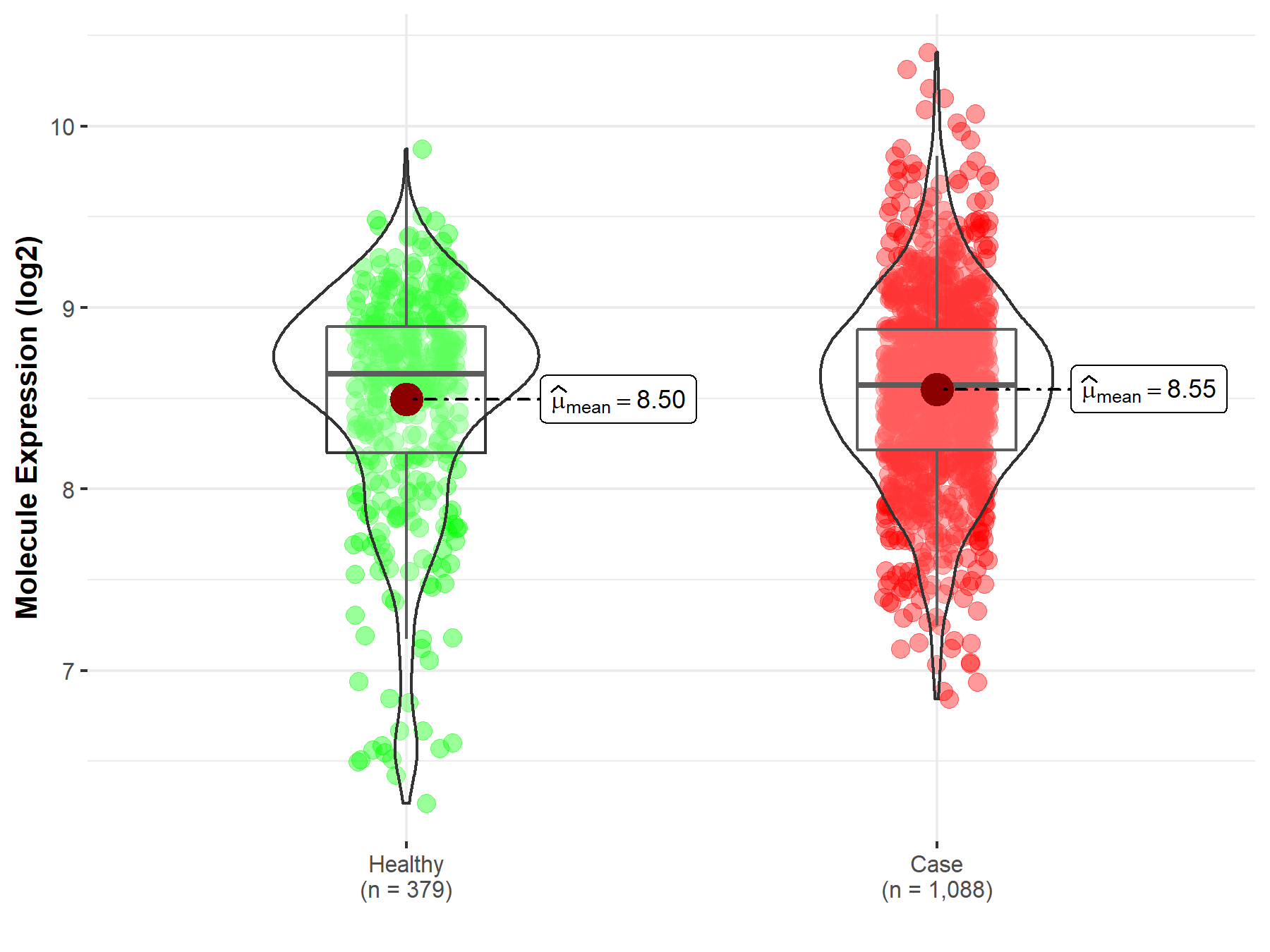
|
Click to View the Clearer Original Diagram |
| The Studied Tissue | Brainstem tissue | |
| The Specified Disease | Glioma | |
| The Expression Level of Disease Section Compare with the Healthy Individual Tissue | p-value: 5.29E-01; Fold-change: 3.97E-01; Z-score: 6.63E-01 | |
|
Molecule expression in the diseased tissue of patients
Molecule expression in the normal tissue of healthy individuals
|
||
| Disease-specific Molecule Abundances |
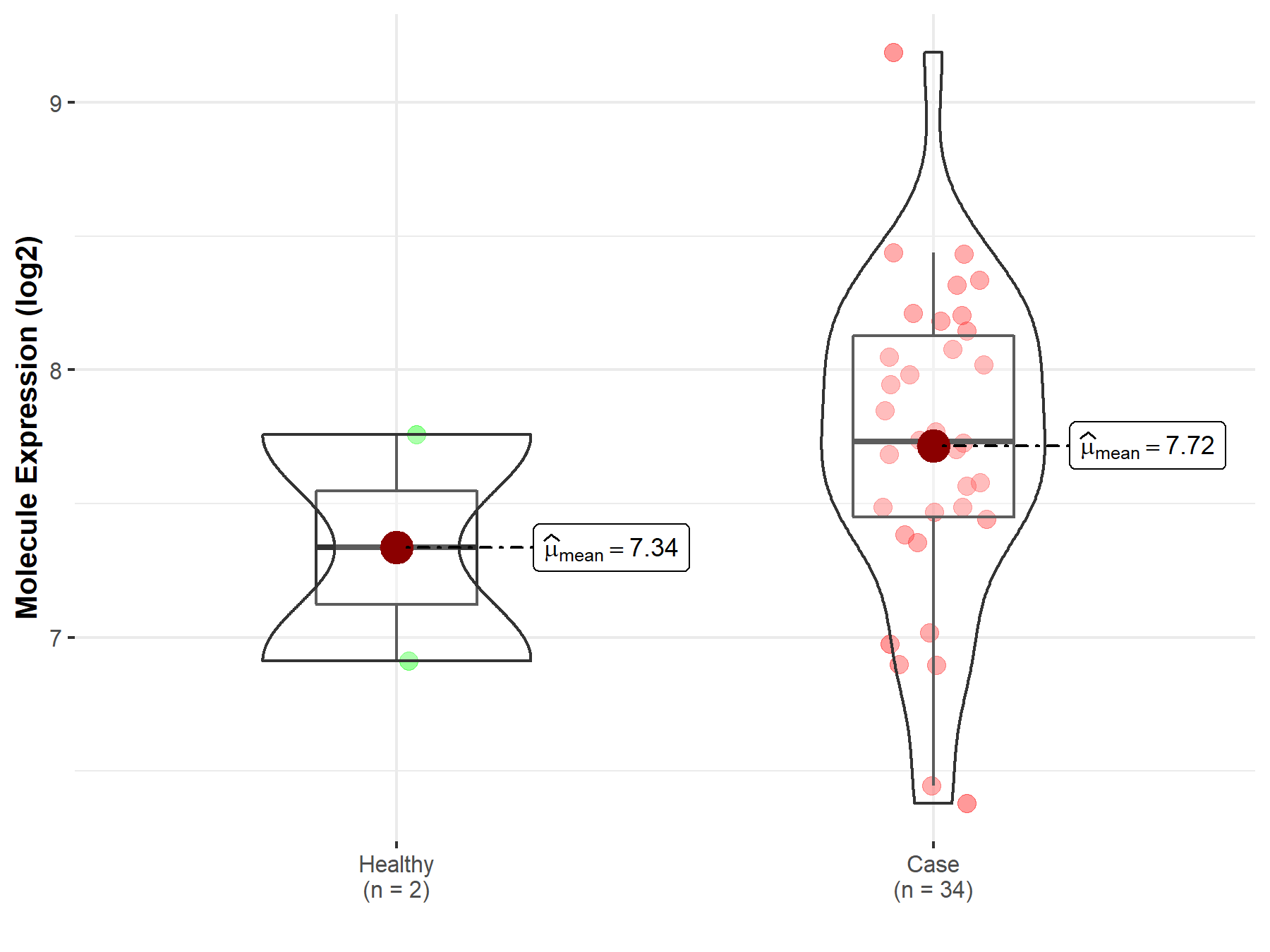
|
Click to View the Clearer Original Diagram |
| The Studied Tissue | White matter | |
| The Specified Disease | Glioma | |
| The Expression Level of Disease Section Compare with the Healthy Individual Tissue | p-value: 7.86E-01; Fold-change: -4.82E-02; Z-score: -1.50E-01 | |
|
Molecule expression in the diseased tissue of patients
Molecule expression in the normal tissue of healthy individuals
|
||
| Disease-specific Molecule Abundances |
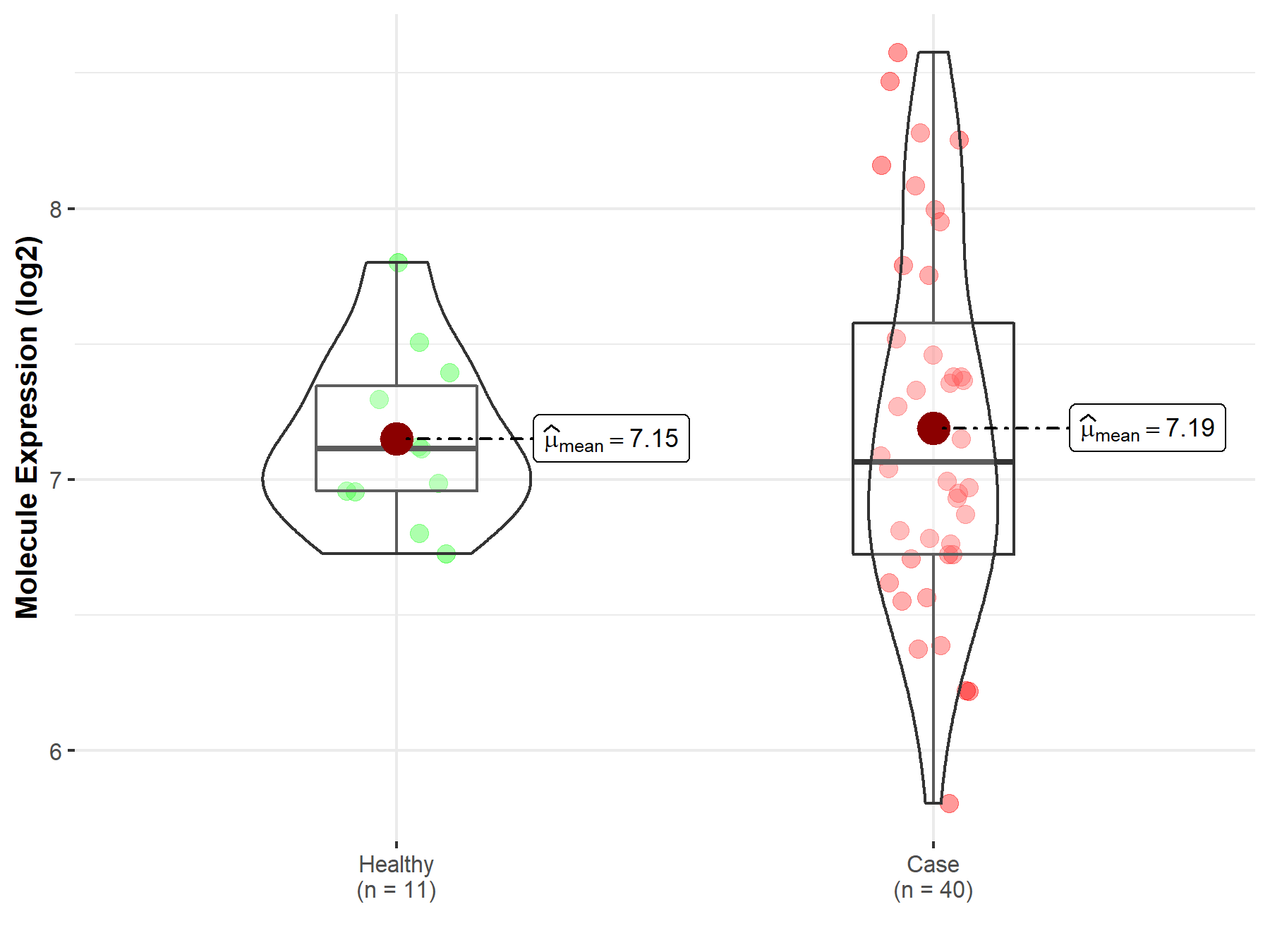
|
Click to View the Clearer Original Diagram |
| The Studied Tissue | Brainstem tissue | |
| The Specified Disease | Neuroectodermal tumor | |
| The Expression Level of Disease Section Compare with the Healthy Individual Tissue | p-value: 4.48E-01; Fold-change: 2.57E-01; Z-score: 5.98E-01 | |
|
Molecule expression in the diseased tissue of patients
Molecule expression in the normal tissue of healthy individuals
|
||
| Disease-specific Molecule Abundances |
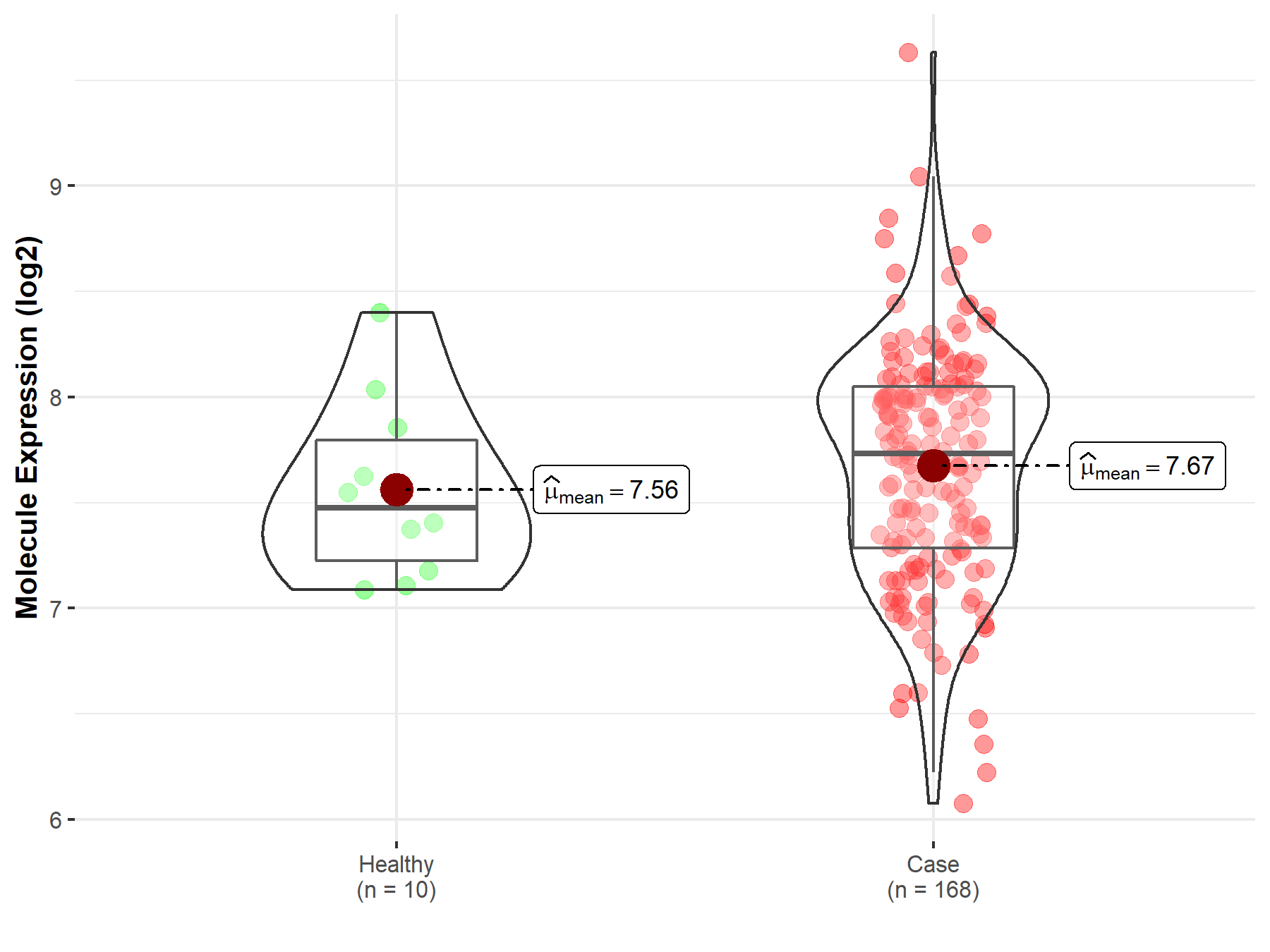
|
Click to View the Clearer Original Diagram |
| Differential expression of molecule in resistant diseases | ||
| The Studied Tissue | Bone marrow | |
| The Specified Disease | Acute myeloid leukemia | |
| The Expression Level of Disease Section Compare with the Healthy Individual Tissue | p-value: 6.06E-02; Fold-change: 1.15E-01; Z-score: 2.41E-01 | |
|
Molecule expression in the diseased tissue of patients
Molecule expression in the normal tissue of healthy individuals
|
||
| Disease-specific Molecule Abundances |

|
Click to View the Clearer Original Diagram |
Tissue-specific Molecule Abundances in Healthy Individuals

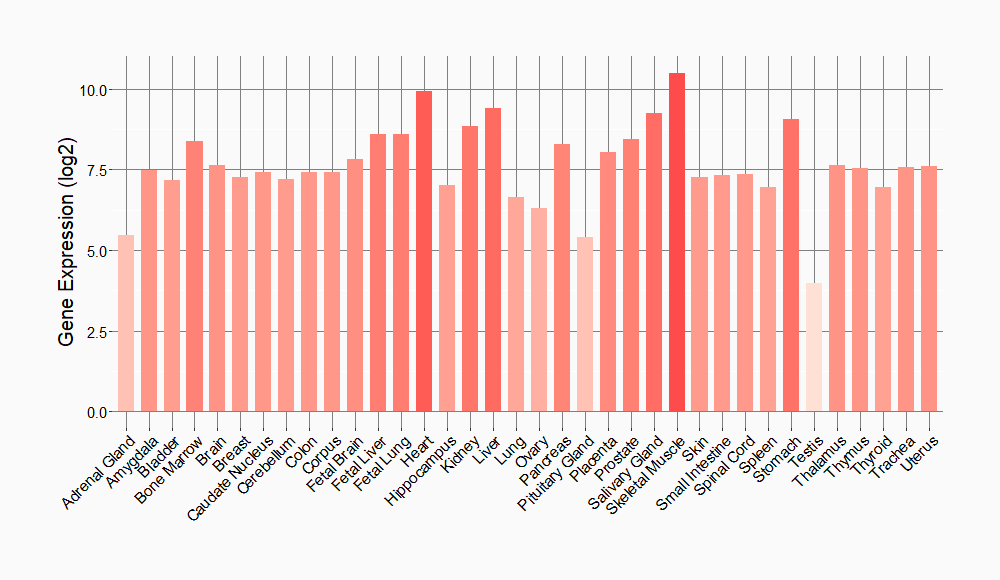
|
||
References
If you find any error in data or bug in web service, please kindly report it to Dr. Sun and Dr. Zhang.
